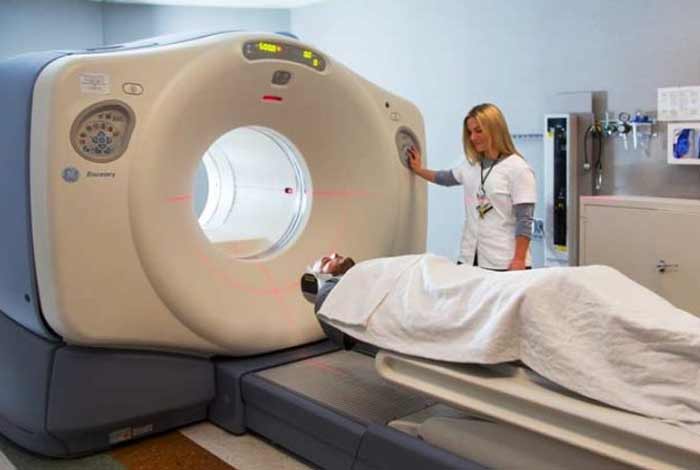
Bone Cancer is a type of tumor, which is malignant in nature and destroys the bone tissues. It must be noted that not all bone tumors are malignant. There are noncancerous or benign bone tumors as well. These benign tumors are more common than malignant tumors or bone cancer. Benign tumors do not destroy bone tissues and do not spread. This is a stark difference between malignant tumors and benign ones.
Malignant tumors starting in bone tissues are known as primary bone cancer. Primary bone cancer is less common than the cancers that occur due to spreading from other parts of the body. Cancers that metastasize from other parts of the body like breast, lung and so on are known as metastatic cancer.
There are other cancers that may start in the bone even when they are not true bone cancers. Lymphoma is a cancer that often begins in the lymph nodes, but it can sometimes, even begin in the bone marrow. There is another type of cancer, known as multiple myeloma, which begins in the bone marrow. These are not primary bone cancers as they do not originate from the real bone cells.
The American Cancer Society has estimated the following numbers for bone cancer for the year 2018:
- Around 3450 new cases of bone cancer will be diagnosed
- Around 50% of identified cases are expected to die
Primary bone cancer makes up less than 0.2% of all cancers. In adults having primary bone cancers, around 40% are chondrosarcomas, 28% are osteosarcomas, 10% are chordomas, 8% are Ewing tumors, and 4% are fibrosarcomas (fibroblastic sarcomas).
Types and Symptoms of Bone Cancer
Types of Bone Cancer:
There are mainly six types of bone cancers that are discussed below:
- Osteosarcoma: It originates in the bone cells of arms, pelvis or legs, and found mostly in men as compared to women. It hits individuals in the age range of 10-30 years.
- Chondrosarcoma: It gets formed in the cartilage cells, and is the 2nd most common type of bone cancer after osteosarcoma. It is generally found in people below the age of 20. The likelihood of having cancer increases with increasing age.
- Ewing Tumor: It generally originates in the bones, but can also start to develop in tissues and muscles. It is not seen in adults above the age of 30. Ewing tumor is frequently seen in children below the age of 20.
- Fibrosarcoma and Malignant Fibrous Histiocytoma: It gets formed in the tissues around the bones like tendons, muscles and ligaments. This is generally found in older population.
- Giant Cell Tumor of Bone: It can be present as both benign and malignant forms. It occurs in the arm or leg bone and is generally seen in adults who are middle-aged. It does not spread to other parts of the body.
- Chordoma: It affects spinal bones and the ones that are situated in the base of the skull. Chordoma is found in adults above the age of 30. Men are most affected by this type of cancer.

Symptoms of Bone Cancer:
When tumor of the bone grows, it can even destroy healthy bone tissues. People having bone cancer can have the following signs and symptoms:
- Pain: The early signs to look out for in case of bone cancer is pain and swelling in the area where tumor is located. Pain may be felt sporadically, i.e., it may be present at some time and then it goes away. Movement may worsen the pain. Soft tissues may swell.
- Swelling and Stiffness in Joints: This will restrict a person’s movement and may cause swelling in joints.
- Limping: It occurs when the bone with the tumor breaks.
Other symptoms may be experienced like fever, anemia, weight loss and low RBC count.

Risk Factors for Bone Cancer
The following risk factors are associated with bone cancer:
- Genetics: People having the history of sarcomas in their family are at a higher risk of developing osteosarcoma.
- Radiation Therapy: People, who have undergone radiation therapy for the treatment of other conditions have a higher chance of developing cancer at the site of radiation therapy.
- Chemotherapy for Another Cancer: Drugs used in chemotherapy like alkylating agents can increase the risk of developing secondary cancer like osteosarcoma.
- Other Bone Conditions and Benign Tumors: Some other bone conditions like fibrous dysplasia also increase the risk of osteosarcoma.

Do I have Bone Cancer?
The most common symptom of bone cancer is pain in the affected bone. Patients may also see swelling in and around the site of pain. Tumors in bones of the spine may compress the spinal cord causing pain, weakness, tingling sensation in legs and arms. It can get difficult to differentiate bone cancer from other bone conditions like spinal compression fractures, arthritis, low back pain and acute injuries. If the symptoms continue particularly with the occurrence of weight loss and fatigue, then one must definitely see a doctor to rule out other possibilities.

Causes and Prevention of Bone Cancer
Causes of Bone Cancer:
It is known that cancer begins as an error in the DNA of the cells. Because of this error, the cells grow and divide in an uncontrolled manner. These cells do not die, but in fact, continue to live and multiply uncontrollably. The cells that do not die accumulate to form tissue masses that result in the development of tumors.
Radiation therapy kills dangerous cancer cells. This is used in the treatment of bone cancer. However, osteosarcoma may form in a few people receiving this treatment.
Other bone conditions like Paget’s disease of the bone can also cause bone cancer. Rare genetic conditions like Li-Fraumeni syndrome can also lead to the development of bone cancer. Furthermore, if a person has a history of some conditions like retinoblastoma and umbilical hernia, his/her likelihood of having bone cancer also increases.

Prevention of Bone Cancer:
Below given are some preventive measures that can be adopted to avoid the development of bone cancer:
- People must be aware whether a relative or anyone in the family has ever been diagnosed with bone cancer.
- One must stay away from negative lifestyle like taking too much stress or smoking as all these can raise the chances of developing bone cancer.
- Follow a low-fat diet and keep a check on nutrition. Some studies have claimed that people, who consume fruits and vegetables have lesser chances of developing cancer.
- Incorporation of physical exercise and yoga may help in preventing the growth of cancer.
- Consultation must be done with doctors before the cancer metastasizes or spreads to other parts of the body.

Diagnosis and Tests for Bone Cancer
Other than physical examination, the following tests may be used for the diagnosis of bone cancer:
- Blood Test: High levels of alkaline phosphate and lactate dehydrogenase may signify sarcoma. Thus, blood test may help detect bone cancer.
- X-Ray: It is used to create pictures of structures within the body using radiation in small amounts.
- Bone Scan: It utilizes a radioactive tracer for looking inside the bones. Tracer is injected into the veins of the patients. Healthy bones look gray in the camera, whereas cancerous cells appear dark.
- Computed Tomography (CT) Scan: It can be used to measure the size of the tumor. A special dye, known as contrast medium is given before the scan. This is injected in the patient’s veins or given as a pill. This provides better detail of the image.
- Magnetic Resonance Imaging (MRI): This technique uses magnetic fields to create detailed body images. In this test also, contrast medium is given for the creation of a better image. MRI helps detect tumors in the nearby tissues as well.
- Positron Emission Tomography (PET) Scan: It creates images of organs and tissues present in the body. A small amount of glucose or radioactive sugar is given to the patient. Cancer cells absorb the radioactive substance and then, a scanner is used to create the images of body organs.
- Biopsy: A small amount of tissue is removed for examination under the microscope. This is known as the biopsy, which is a definite way to ensure that the presence of cancer. Depending on the location of cancer, needle biopsy or incisional biopsy is done. In the needle biopsy, tissue is removed using a needle-like instrument. During the incisional biopsy, small cuts are made in the tumor.

Treatment and Care for Bone Cancer
Treatment of Bone Cancer:
The following treatment methods are employed to treat bone cancer:
- Surgery: The aim of the surgery is to completely remove the bone cancer. It is possible that the surgery may remove the bone cancer and limb be spared. Since the bone is also lost with the surgery, the area gets replaced with bone from some other part. If the bone cancer is found in areas other than arms and legs, surgery may remove bones and the tissues. Bone cancers that are too large and are present in some complicated location, then surgery may be required to remove the complete or part of the limb. This is known as amputation. An artificial limb may be used to make up for the lost limb.
- Chemotherapy: In this approach, chemicals are used to kill the cancerous cells. It is given intravenously, i.e., injected through a vein. The medications used in chemotherapy then travel throughout the body. Chemotherapy may also be used in people in whom the cancer has spread to other areas of the body.
- Radiation Therapy: This technique uses high powered beams of energy for killing the cancer cells. During this therapy, the patient is made to lie on a table and a machine moves around the patient and directs the energy beam at the exact points on the body. Radiation therapy is used in combination with chemotherapy. It is used before the surgical procedure. It diminishes the chances of having to go through amputation. Radiation therapy is also useful in cases in which surgery has failed. It may be done after surgery to kill the left-behind cancer cells. In cases of advanced bone cancer, radiation therapy may help in managing symptoms like pain.

Care for People with Bone Cancer:
The following points may be noted while taking care of bone cancer patients:
- Regularly monitoring the condition of the patient and noting down observed changes
- Analyzing and interpreting the observations
- Participating in key decisions that have to be made regarding the patients
- Delivering hands-on care
- Accessing resources that are needed to take care of the patient
- Providing care to the patient without threatening the autonomy and individuality of the patient
- Helping them to carry out day-to-day activities.

OTC Medications and Self-Management Methods for Bone Cancer
Over-the-Counter Medications for Bone Cancer:
There are no OTC medicines available for treating bone cancer. In fact, taking any medicine without consulting a doctor will do more harm than good. So, it is advised to consult an oncologist before starting any medication.
Self-Management Methods for Bone Cancer:
Some changes in lifestyle may help manage the symptoms of bone cancer. These are discussed below:
- Prevent Infection: Cancer may cause the immune system of the person to weaken. One must keep his/her hands clean. Hands must be washed periodically to reduce infection. Don’t come in contact with people, who have cold, flu and sore throat. Don’t eat outside. Also, reduce the consumption of raw food. Food must be cooked before consumption.
- Cut Out on Smoking: Smoking is known to increase the risk of cancer. It can also slow down the process of healing. Alcohol consumption must also be limited.
- Exercise: It beats anxiety and fatigue and enhances mood. Health care provider must be consulted for advising the best exercise option or plan. Also, do not opt for intensive exercise. Taking rest periodically is recommended.

Natural Ways to Cure Bone Cancer
Some effective natural remedies to manage bone cancer are discussed below:
- Milk Thistle: It has antioxidants that help in considerable reduction of cancer treatment side effects. It is available as a capsule. Its seeds can be eaten or can be consumed in the form of tea.
- Daily Diet: Along with the inclusion of green leafy vegetables and fruits, daily diet must have appropriate amounts of vitamin A. Vitamin A has been known to kill bone cancer cells.
- Sun Bathing: Make sure that you receive a good amount of sunlight. Vitamin D present in sunlight reduces the rate of multiplication of bone cancer cells.
- Green Tea: It has antioxidant and anti-cancerous properties. It acts as a natural remedy for bone cancer.
- Herbs: Herbs like Equisetum, blue flag, reishi mushroom and rose hips are useful in treating bone cancer. These herbs can be used as tinctures, glycerites and extracts. One can even prepare tea by boiling herb in water.
- Aloe Vera: It contains a chemical compound known as Aloe vera, which helps fight against cancer.
- Minerals: A person suffering from bone cancer must make every effort to keep the bones healthy. Consumption of calcium is important as also magnesium and strontium as these strengthen the bones. Cesium chloride can also be used to maintain bone health. Supplements are available in tablet form.

Health Tip by Expert
Eat a high-protein, high-calorie diet before and during the treatment of bone cancer, so that the body has enough energy to be able to make through the treatment.




